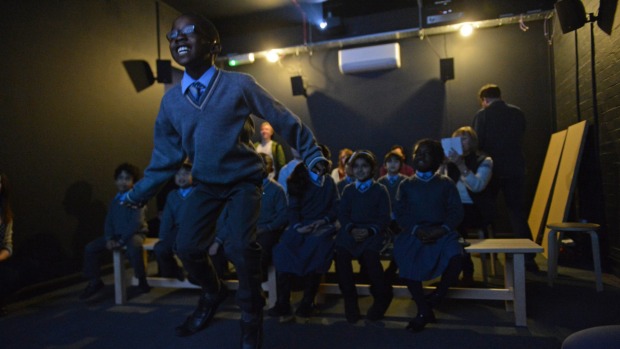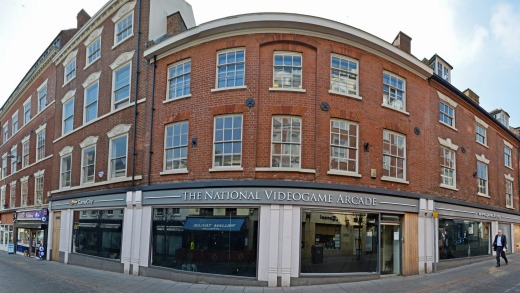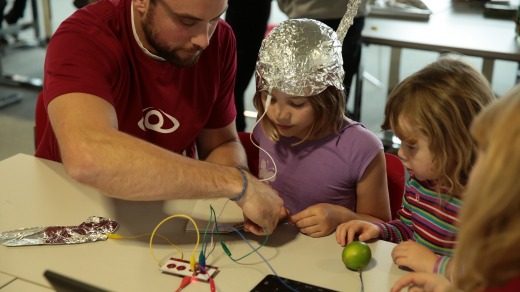
I try to time the leap with precision. Get it wrong, and it'll mean tumbling dozens of storeys to a certain death. I take off and pray that I'll manage to reach the ledge on the other building.
Alas, only my face does. It smashes into the side of the wall, and I plummet to my doom.
Now this sort of thing is bad enough when the only physical exertion is waggling a joystick. But when you're jumping around getting hot and sweaty for the purposes of a game, it's particularly galling.

The game is Canabalt, which was originally designed for the iPhone as a game that could be played solely by pressing one button. Basically, the man runs across the screen; the player has to press the button to leap over obstacles or between buildings in traditional platform-game style.
But the newly opened National Videogame Arcade in Nottingham, England, has put a rather different twist on it. Canabalt has been wired up so that instead of hammering a button on a phone, there's a weight-sensitive pad on the floor connected to a big screen. If you want the little man to jump, you have to jump as well. Swearing whenever your timing is wrong is strictly optional.
High-speed chases are repeatedly hamstrung by people lobbing in dolls, colanders and toilet brushes from the sidelines.
Approaching games differently is a common theme throughout the National Videogame Arcade, which really, really doesn't want to be called a museum and only really has one conventionally museum-like room. This drearily encased collection of old consoles, marketing tie-ins and short-lived controllers can be happily skipped in favour of the fun stuff.

The National Videogame Arcade is a spin-off of the Gamecity festival, which has been looking at video games from a cultural perspective since 2006. The Arcade is, to all intents and purposes, a permanent base for the festival. But it is also somewhere designed to introduce non or casual gamers to different aspects of game playing and making.
Some components of this are utterly predictable. There are loads of old arcade machines scattered around to while away time y on. There are also plenty of old consoles set up with classic games such as Sonic The Hedgehog and Manic Miner.
Another room is set up like a living room, and is aimed at people who want to sit down and play for a good stint. And elsewhere, certain games get big-screen treatment – handy for anyone wanting to be Cedric Pioline playing Yevgeny Kafelnikov at Virtua Tennis.
Such nostalgic time-passing is rather enjoyable, but it hardly warrants spending $4 million on a special cultural centre. Thankfully, such installations are very much used as padding – something to keep visitors entertained while the centrepieces are occupied by someone else.
The first of these centrepieces is Mission Control, which on initial inspection resembles classic '80s game Asteroids. Spaceships made up of rudimentary, blocky graphics move around shooting at all and sundry. But the two players moving the spaceships around aren't the only ones controlling things. Around the room are all manner of buttons and switches for passers-by to press and flick. Each changes something, from the graphics and music to the rules. Elsewhere, there is a scanner, where people can draw things and introduce them to the game as new baddies to tackle. It becomes gloriously, absurdly anarchic, but serves to make everyone involved think about the components that go into making a video game.
In the next room is an ostensibly simple game whereby cars drive around shooting at each other through weaponised headlights. The twist is that said cars are projected on to the floor, and their movement is impeded by whatever real-life objects are thrown in their way. So high-speed chases are repeatedly hamstrung by people lobbing in dolls, colanders and toilet brushes from the sidelines.
Elsewhere, bananas with wires attached to them are used as controllers, the parameters and perils of a game set on a space station are changed according to what happens in real-time Wikipedia edits and "Game Inspector" allows you to zoom in and see exactly how a Super Mario Bros level is put together.
At every step, perceptions of how video games work are skewed and thoughts on how they are put together are stirred. In a place that's surprisingly low on gloss and state-of-the-art digital wizardry, that's both highly admirable and a sign of successful execution. It's playing with the players as much as the games.
THREE MORE GREAT TECH-BASED MUSEUMS
ELECTRONIC MUSIC PROJECT IN SEATTLE
Set up by Microsoft co-founder Paul Allen, this huge, architecturally bold celebration of all things musical contains several ambitious installations. Highlights include touch-screen interactions that delve into some of the world's most famous music videos, one of the most gigantic LED screens on earth and a glorified karaoke room that allows visitors to perform on stage in front of a virtual audience. See empmuseum.org.
ARS ELECTRONICA IN LINZ, AUSTRIA
Bang up to date, Ars Electronica isn't just interested in cutting-edge technology – it is interested in how to turn it into thought-provoking art. Among numerous fascinating exhibits are a timelapse video tracing a Berlin politician's movements over months, using data obtained from his mobile phone records plotted against a map. Other installations will get you seriously worried about how much information Facebook has on you. See aec.at.
THE TECH IN SILICON VALLEY, CALIFORNIA
The home of the electronics industry has its own, distinctly family-focused museum. Exhibits look into the major developments being worked on, such as wearable technology, biotech and how robots are being made increasingly sociable. See thetech.org.
TRIP NOTES
MORE INFORMATION
ExperienceNottinghamshire.com
GETTING THERE
Nottingham is about 90 minutes north of London by train. See Eastmidlandstrains.co.uk.
Etihad is among several airlines flying from Sydney and Melbourne to London, in this case via Abu Dhabi. See Etihad.com.
STAYING THERE
The St James Hotel has entertainingly blinged up a formerly shabby old joint. It's good value for from $135 a night. See stjames-hotel.com
SEE AND DO
Entry to the National Videogame Arcade costs $17. See gamecity.org.